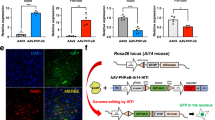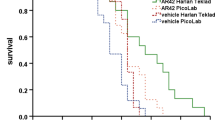Abstract
Spinal muscular atrophies (SMAs) are hereditary disorders characterized by degeneration of lower motor neurons. Different SMA types are clinically and genetically heterogeneous and many of them show significant phenotypic overlap. We recently described the clinical phenotype of a new disease in two Finnish families with a unique autosomal dominant late-onset lower motor neuronopathy. The studied families did not show linkage to any known locus of hereditary motor neuron disease and thus seemed to represent a new disease entity. For this study, we recruited two more family members and performed a more thorough genome-wide scan. We obtained significant linkage on chromosome 22q, maximum LOD score being 3.43 at marker D22S315. The linked area is defined by flanking markers D22S686 and D22S276, comprising 18.9 Mb. The region harbours 402 genes, none of which is previously known to be associated with SMAs. This study confirms that the disease in these two families is a genetically distinct entity and also provides evidence for a founder mutation segregating in both pedigrees.
Similar content being viewed by others
Log in or create a free account to read this content
Gain free access to this article, as well as selected content from this journal and more on nature.com
or
References
Irobi J, Dierick I, Jordanova A, Claeys KG, De Jonghe P, Timmerman V : Unraveling the genetics of distal hereditary motor neuronopathies. Neuromolecular Med 2006; 8: 131–146.
Van Den Bosch L, Timmerman V : Genetics of motor neuron disease. Curr Neurol Neurosci Rep 2006; 6: 423–431.
Zerres K, Rudnik-Schoneborn S : 93rd ENMC international workshop: non-5q-spinal muscular atrophies (SMA)–clinical picture (6–8 April 2001, Naarden, The Netherlands). Neuromuscul Disord 2003; 13: 179–183.
Darras BT : Non-5q spinal muscular atrophies: the alphanumeric soup thickens. Neurology 2011; 77: 312–314.
Puls I, Jonnakuty C, LaMonte BH et al: Mutant dynactin in motor neuron disease. Nat Genet 2003; 33: 455–456.
Kennerson ML, Nicholson GA, Kaler SG et al: Missense mutations in the copper transporter gene ATP7A cause X-linked distal hereditary motor neuropathy. Am J Hum Genet 2010; 86: 343–352.
Antonellis A, Ellsworth RE, Sambuughin N et al: Glycyl tRNA synthetase mutations in Charcot-Marie-Tooth disease type 2D and distal spinal muscular atrophy type V. Am J Hum Genet 2003; 72: 1293–1299.
Grohmann K, Schuelke M, Diers A et al: Mutations in the gene encoding immunoglobulin mu-binding protein 2 cause spinal muscular atrophy with respiratory distress type 1. Nat Genet 2001; 29: 75–77.
Windpassinger C, Auer-Grumbach M, Irobi J et al: Heterozygous missense mutations in BSCL2 are associated with distal hereditary motor neuropathy and silver syndrome. Nat Genet 2004; 36: 271–276.
Irobi J, Van Impe K, Seeman P et al: Hot-spot residue in small heat-shock protein 22 causes distal motor neuropathy. Nat Genet 2004; 36: 597–601.
Evgrafov OV, Mersiyanova I, Irobi J et al: Mutant small heat-shock protein 27 causes axonal Charcot-Marie-Tooth disease and distal hereditary motor neuropathy. Nat Genet 2004; 36: 602–606.
Kolb SJ, Snyder PJ, Poi EJ et al: Mutant small heat shock protein B3 causes motor neuropathy: utility of a candidate gene approach. Neurology 2010; 74: 502–506.
McEntagart M, Norton N, Williams H et al: Localization of the gene for distal hereditary motor neuronopathy VII (dHMN-VII) to chromosome 2q14. Am J Hum Genet 2001; 68: 1270–1276.
Gopinath S, Blair IP, Kennerson ML, Durnall JC, Nicholson GA : A novel locus for distal motor neuron degeneration maps to chromosome 7q34-q36. Hum Genet 2007; 121: 559–564.
Nishimura AL, Mitne-Neto M, Silva HC et al: A mutation in the vesicle-trafficking protein VAPB causes late-onset spinal muscular atrophy and amyotrophic lateral sclerosis. Am J Hum Genet 2004; 75: 822–831.
Rudnik-Schoneborn S, Botzenhart E, Eggermann T et al: Mutations of the LMNA gene can mimic autosomal dominant proximal spinal muscular atrophy. Neurogenetics 2007; 8: 137–142.
Deng HX, Klein CJ, Yan J et al: Scapuloperoneal spinal muscular atrophy and CMT2C are allelic disorders caused by alterations in TRPV4. Nat Genet 2010; 42: 165–169.
Takashima H, Nakagawa M, Suehara M et al: Gene for hereditary motor and sensory neuropathy (proximal dominant form) mapped to 3q13.1. Neuromuscul Disord 1999; 9: 368–371.
Harms MB, Allred P, Gardner R et al: Dominant spinal muscular atrophy with lower extremity predominance: linkage to 14q32. Neurology 2010; 75: 539–546.
Jokela M, Penttila S, Huovinen S et al: Late-onset lower motor neuronopathy: a new autosomal dominant disorder. Neurology 2011; 77: 334–340.
Kong A, Gudbjartsson DF, Sainz J et al: A high-resolution recombination map of the human genome. Nat Genet 2002; 31: 241–247.
Abecasis GR, Cherny SS, Cookson WO, Cardon LR : Merlin–rapid analysis of dense genetic maps using sparse gene flow trees. Nat Genet 2002; 30: 97–101.
Al-Chalabi A, Andersen PM, Nilsson P et al: Deletions of the heavy neurofilament subunit tail in amyotrophic lateral sclerosis. Hum Mol Genet 1999; 8: 157–164.
Taherzadeh-Fard E, Saft C, Wieczorek S, Epplen JT, Arning L : Age at onset in Huntington's disease: replication study on the associations of ADORA2A, HAP1 and OGG1. Neurogenetics 2010; 11: 435–439.
Yang H, Sasaki T, Minoshima S, Shimizu N : Identification of three novel proteins (SGSM1, 2, 3) which modulate small G protein (RAP and RAB)-mediated signaling pathway. Genomics 2007; 90: 249–260.
Acknowledgements
This study was supported by Finska Läkaresällskapet grant.
Author information
Authors and Affiliations
Corresponding author
Ethics declarations
Competing interests
The authors declare no conflict of interest.
Rights and permissions
About this article
Cite this article
Penttilä, S., Jokela, M., Hackman, P. et al. Autosomal dominant late-onset spinal motor neuronopathy is linked to a new locus on chromosome 22q11.2-q13.2. Eur J Hum Genet 20, 1193–1196 (2012). https://doi.org/10.1038/ejhg.2012.76
Received:
Revised:
Accepted:
Published:
Issue date:
DOI: https://doi.org/10.1038/ejhg.2012.76



